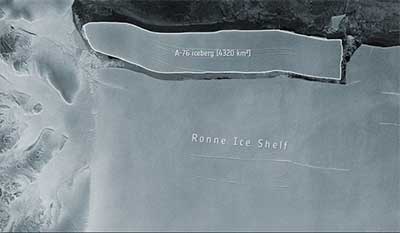World’s largest iceberg has broken off from Antarctica
In news
The European Space Agency (ESA) has claimed that the world's largest iceberg has broken off from an ice shelf in Antarctica and is floating through the Weddell Sea.
About
The largest iceberg is named as A-76 and is roughly the shape of Manhattan but more than 70 times bigger than it.
The iceberg approximately measures 170 kilometres (105 miles) long and 25 kilometres wide, with an area of 4,320 square kilometers.
The iceberg broke off from the western side of the Ronne Ice Shelf, was initially identified by the British Antarctic Survey and verified using images from the Copernicus satellite.
In November 2020, the then world's largest iceberg emerged to be on a collision course with a remote South Atlantic island home to thousands of penguins and seals, threatening to obstruct their ability to gather food.
Another iceberg, known as A68a, had also broken off from the Larsen Ice Shelf, which has warmed faster than any other part of Earth's southernmost continent. It is 160 kilometres long and 48 kilometres across, crashed before it could cause any damage to the rich wildlife in the British Overseas Territory of South Georgia.
Earth's average surface temperature has risen by one degree Celsius since the 19th century, sufficient to increase the intensity of droughts, heatwaves and tropical cyclones. But the air over Antarctica has warmed more than twice that much.
Larsen Ice Shelf’s major part has disintegrated which had been stable for more than 10,000 years within days in 1995, and again in 2002 and after that nearby Wilkins Ice Shelf also broke apart in 2008 and 2009.
Research claims that a process known as hydrofracturing was probably the main reason for this breaking of two ice bergs.
Hydrofracturing takes place when water that is heavier than ice flows through cracks in the surface of ice shelves caused by surface warming, violently forcing the fractures to zip open, and causing an iceberg to break off.
Icebergs are traditionally named after the Antarctic quadrant in which they were at first detected, followed by a sequential number.More letters are added to differentiate the fragments if they further break apart.







